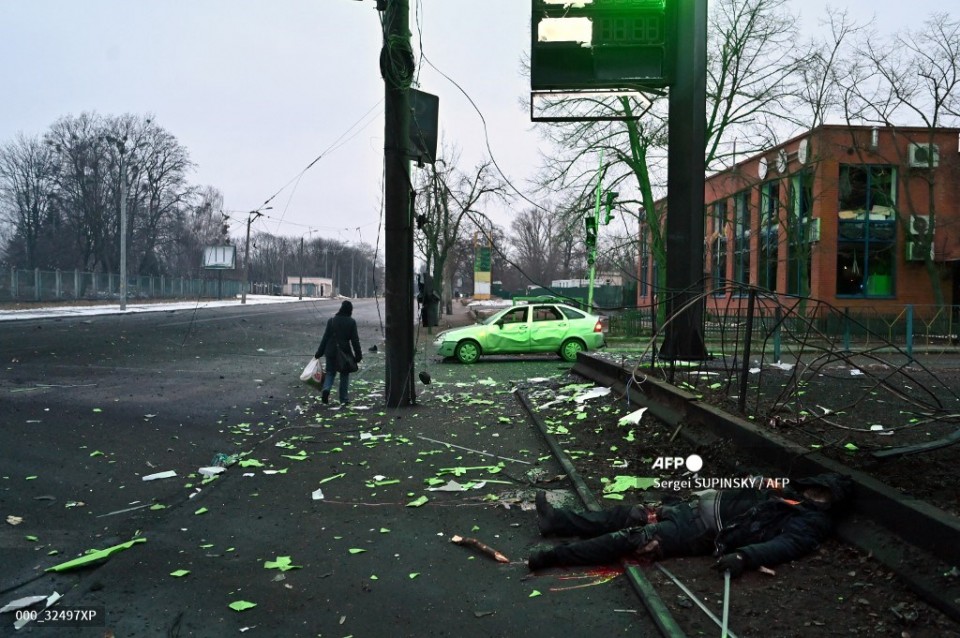
“We have our agents living with the locals,” Spear unit commander Viktor Chelovan said.
“If strangers come into our villages, people send us signals, call us, and we go out and take care of these saboteurs.”
A fear of Russians disguised as locals is gradually gripping Ukraine.
It crept into Kyiv when Russian paratroopers dropped into a local airfield on the northwestern edge of the city in the first hours of their invasion of Ukraine last Thursday.
The precise number who landed — or who survived the Ukrainian counter-offensive — is unclear.
But residents of the neighbouring village of Irpin have been reporting strange things in their woods ever since.
“We have people who look like locals shooting at other locals,” said Irpin resident Andriy Levanchuk.
The 39-year-old financial adviser was using a perilous-looking crossing made of pipes and wires to get to the other side of the small but surprisingly rapid Irpin River.
The regular bridge above him was blown up by Ukrainian forces to halt the Russian advance.
“These are Russian paratroopers who hide in the woods, enter people’s apartments, take their clothes, change and try to walk around in civilian clothes,” Levanchuk said.
Military analysts believe Levanchuk’s hunch about strangers in the woods might be right.
– Local lookouts –
Mykola Beleskov of Kyiv’s National Institute for Strategic Studies said Russia was “employing special forces of different kinds en masse” to try and capture the Ukrainian capital.
“They are trying to combine airstrikes, artillery and infiltration commandos, who basically provide support for a very gradual advance,” he said.
The Russian advance on the historic city seemed imminent when the paratroopers arrived.
But Ukrainian forces put up a stiff resistance at the city’s northern entrance and then recaptured the airfield.
They then started blowing up bridges and setting up barricades across the city to stall the invasion by any means possible.
Kyiv residents such as 19-year-old student Ibrahim Shelia further took matters into their own hands.
Shelia and his friends began digging a trench in front of their building to lob Molotov cocktails at the Russian tanks.
Yet they also decided to keep a close eye out for people who look like they do not belong.
“The other day, with my guys, we stopped a car that some local people had tipped us off about,” Shelia said a few minutes before Kyiv entered its nightly curfew — another measure aimed at better fighting intruders.
“There were four people inside with two maps of Ukraine, two laptops and everyone had two Ukrainian passports: the first was the new version, the second the old one,” he said.
“We immediately called the police. Everyone was arrested and taken away.”
– ‘Kill the leaders’ –
The mayor of Irpin also said his men had picked up some Russians after a tip from one of the local villagers.
“Of course there are saboteurs,” mayor Oleksandr Markushin said while inspecting the remains of his town’s main bridge.
A few policemen nearby argued about how long it might take to repair their town’s crossing to Kyiv once the war ends.
But the special forces commander had no time for idle chitchat and tried to steer the conversation toward the threat at hand.
“There are three types of saboteurs,” he said.
“There are the Russian special forces and GRU (military intelligence) planted here before the war. Their main job was to assist the Russian invasion,” he said.
Chelovan said the second group was sent in “to destabilise daily life” with various attacks.
“The third group are intelligence agents whose only goal is to kill various Ukrainian leaders,” said the commander.
A group of volunteer soldiers were trying to manuever a new shipment of Kalashnikovs across the makeshift river crossing as he spoke.
“But most importantly, they are trying to kill the leaders of the people’s resistance movement,” Chelovan said.
dar-zak/jbr/jv
© Agence France-Presse







